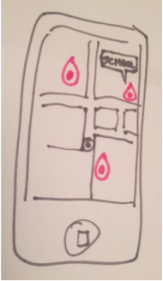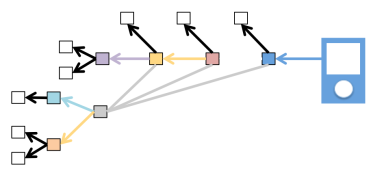My current hero is Dan Marsh. Dan is a business analyst who has just finished his apprenticeship at my client. Dan had the courage to say that what I taught about Feature Injection’s working backwards (That tea bag stuff) actually scared him. Subsequently we had a great session to understand what he found so scary. As a result we came up with the following approach to explain “Work Backwards”. I will explain the subtle but important changes at the end.
We are skipping the “Hunt the value” or “OO” part of Jennie’s “OOPSI” model. And lets assume we have designed one or more “Output” that satisfies our “Outcome” (Design Brief – “We satisfy the “Need” of a “Group of Customers” and as a result the business received value which we measure using a “Metric”).
Consider the Design Brief (As a “Super Fan” I have a need to know “where my favourite celebrities went to school and played their first gigs so that I can go on a pilgrimage” and as a result the company will get more “Super fans”). So the product squad have collaborated on and tested and user tested designs to the point they have an experiment they want to scale out to more of the “Super fans”.
The design they come up with is “A mobile phone app to enable you to do a walking tour of a city to see all the locations where your favourite celebrity lived and played). Something like…

We create an initial Epic to build the experimental product. “Mobile App One to meet Design Brief”. Normally at this point we would break the Epic into stories. Instead we write the Acceptance Criteria using the Given-When-Then format. We start with the Value in creating our value stream. the thing that gives value to the customer, the THEN…
- THEN the application displays a map
- AND the current location is at the center of the map
- AND the location of celebrity sites
- AND the name of the important celebrity sites
So what are the things that could go wrong? Lets consider these as TODO’s that we will come back to in this Epic or more likely in other Epics.
- TODO – The centre of the maps is a specified location (e.g. Zip/Post Code)
- TODO – There are no celebrity sites (An arrow at the edge of the map indicating direction of closest site?)
- TODO – There are no important celebrity sites
We now consider when the app displays the map. The normal response is to suggest when the app is opened. Alternatively it could be when the phone is near to one of the sites.
- WHEN the phone is within the specified distance
And another TODO which will almost certainly go into another Epic.
- TODO – When the app is opened.
We need to update the THEN as well to include an alert.
- THEN the application displays a map
- AND the current location is at the center of the map
- AND the location of celebrity sites
- AND the name of the important celebrity sites
- AND the phone alerts the user
Now we can look at the necessary conditions for this to happen.
- GIVEN user has selected a celebrity
- AND there are celebrity sites nearby
- AND user has marked celebrity site as important
- AND user has enabled location services
- AND user has enabled alerts
- AND the user is logged in.
With an associated set of TODOs that go in additional Epics…
- TODO user has not selected a celebrity
- TODO there are no celebrity sites nearby
- TODO user has not marked celebrity site as important
- TODO user has not enabled location services
- TODO user has not enabled alerts
- TODO user is not logged in
Each GIVEN becomes a THEN in another scenario… For example
- THEN the user has selected a celebrity
- WHEN the user “snapz” the celebrity
- GIVEN the user has selected a celebrity site
- AND the user is logged in
… with associated TODOs, And the GIVEN in this scenario becomes a THEN in another scenario.
- THEN the user has selected a celebrity site
- WHEN the user “snapz” a celebrity site
- GIVEN the user is viewing the map
- AND a celebrity site is visible on the map
- AND the user is logged in
… with associated TODOs (Only a couple mentioned)
- TODO – User is looking at the list of celebrities.
- TODO – User selects a band with more than one member.
And the GIVEN in this scenario becomes a THEN in another scenario.
- THEN the user is logged in
- WHEN the user presents their thumb print to the phone
- GIVEN the user has entered the app
- AND has registered using their thumb print
TODO – User name and password… because everyone does it that way. Just like putting the engine at the front of the car because people are used to seeing the horses before the cart, and like the idea of putting the “Cart before the horse”.
We can visualise the pattern of the scenarios evolving from the output to the inputs as follows:

Which we can summarise as:

And then we can reveal the pattern more clearly if we zoom out even further (and I’ve changed the TODO’s to clear boxes) as follows:

This is the insight that Dan Marsh gave me. This is a natural way for people to work, from left to right. That means the output is on the left and the inputs are on the right which is contrary to the way I have represented this in the past. Also the natural way to write for THEN-WHEN-GIVEN is top to bottom whereas I have been teaching them to write GIVEN-WHEN-THEN from bottom to top which is also counter to the way people think. The right to left representation that confused people is below:

Dan also helped me understand the follow representation that I had used was also confusing.

So from now on, the process flow to write scenarios is left to right, top to bottom, with the arrows pointing left to right.
Thank you Dan for being honest about your thoughts. I think this is a huge insight. 🙂
From now on, I’m going to remove the cognitive dissonance. From now on, Its all about working forward from the output to the inputs.




